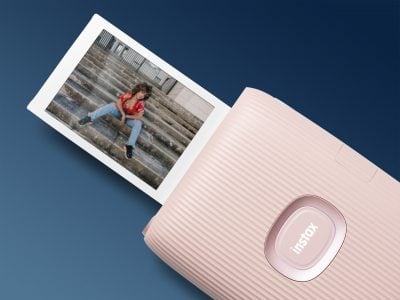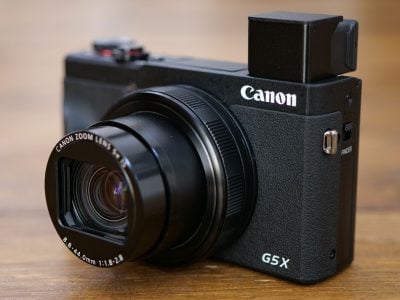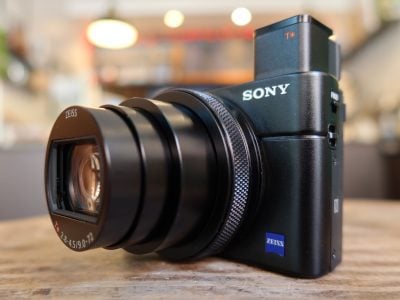Panasonic Lumix DMC-L10
-
-
Written by Gordon Laing
Panasonic Lumix DMC-L10 verdict
The Panasonic Lumix DMC-L10 is a very capable DSLR with a quality stabilised kit lens and some truly unique features. Live View really comes into its own on the L10 with a flip-out screen which allows you to easily compose shots at unusual angles, and it’s amazing this is the first time we’ve seen one on a DSLR since the Olympus E-330. The L10’s contrast-based AF also allows you to auto-focus in Live View without noisily flipping the mirror down and up again, while additionally supporting fun features like face detection.
In terms of traditional photographic respects, the L10 feels well-built, handles fairly well and comes with one of the best kit lenses around – which also features stabilisation. And once again the SSWF proved to be the most effective means to hide dust marks even if the particles weren’t always shaken-free.
So far so good, but the L10 isn’t without its faults. The optical viewfinder, like most Four Thirds models, appears smaller than rival DSLRs – although to be fair you do get used to it. The continuous shooting is a bit of a disappointment, with the rate slowing at higher sensitivities and a buffer which can only accommodate three RAW frames at a time. We also felt the default image processing settings could do with a slight boost in sharpening, but that’s easily fixed from a menu or in post. And while the contrast-based AF is neat, it only works with a compatible lens: which means only one of two at the time of writing, and you also have to wonder if companies like Olympus and Sigma will support the feature in their future lenses.
The biggest problem facing the L10 though is price. Perhaps Panasonic has wisely chosen not to compete at the cut-throat level of models like the Canon 400D / XTi, Nikon D40x and Sony A100. And by equipping it with a superior, stabilised kit lens and features like Live View and a flip-out screen, it’s certainly a step-up from these budget models.
But how big a step? Is it really worth double the price of the 400D / XTi kit, or around $500 USD more than the Olympus E-510 twin lens bundle? In fact, for a little less than the L10 kit, you could buy a Canon EOS 40D, albeit without a lens. So as always, let’s weigh-up the competition.
Compared to Canon EOS 400D / Rebel XTi
 |
Canon’s EOS 400D / XTi is the best-selling 10 Megapixel DSLR, so represents competition for any new model. Panasonic’s Lumix L10 stacks up very well though, beating it in almost every respect. The L10 has a far superior kit lens with optical stabilisation, Live View with a flip-out screen, contrast-based AF and face detection, much more effective anti-dust facilities, and superior build quality, ergonomics and controls.
In its favour, the 400D / XTi has a slightly bigger view through its viewfinder, a comfortably smaller and lighter kit combination and superior image quality at 800 and 1600 ISO. Oh and just one more thing: the 400D / XTi kit is roughly half the price of the L10 kit. The L10 is undoubtedly a much better-featured camera with a far superior kit lens, but you’ll have to carefully weigh-up whether its features are worth the money. See our Canon EOS 400D / XTi review for more details.
Compared to Sony Alpha DSLR-A100
 |
Sony’s Alpha DSLR-A100 is another big seller in the 10 Megapixel market, although again the L10 compares favourably. The A100’s kit lens is better than many, but not as good as the Leica 14-50mm, while the Lumix L10 body additionally features Live View with a flip-out screen, contrast-based AF and face detection, much more effective anti-dust facilities, along with arguably superior build quality.
In its favour, the A100 body features built-in sensor-shift stabilisation which you may not be able to see though the viewfinder, but it will work with any lens you attach. Its viewfinder view is also a little bigger than the L10, although again the big difference is price with the A100 kit coming in much lower. See our Sony Alpha DSLR-A100 review for more details.
Compared to Olympus E-510
 |
One of the fairest comparisons is against the Olympus E-510, as both it and the Lumix L10 share the same Four Thirds lens mount, the same anti-dust facilities and the same 10 Megapixel sensor. Both cameras also have Live View and stabilisation as part of their standard kits, although the E-510’s is built-into the body so works with any lens, whereas the L10’s is lens-based, although this does mean you see the effect through the viewfinder.
In its favour, the L10 makes Live View much more useful with its flip-out screen, while the contrast-based AF is the icing on the cake. The Leica 14-50mm is also superior to the Olympus kit lenses, and the L10’s overall build quality and ergonomics are arguably better than the E-510. But once again price is on the side of the competition and for about $500 USD less than the L10 kit, you could buy the E-510 with two lenses. See our Olympus E-510 review for more details.
Compared to Nikon D80
Nikon’s D80 has become a popular choice for anyone wanting a step-up from a budget 10 Megapixel DSLR and will be a close rival to the L10 as the kit prices are similar. The build quality between it and the L10 are similar, although arguably the ergonomics of the D80 have the edge. The D80’s viewfinder is also much bigger to look through and the camera as a whole feels like a very capable photographic tool. The L10 is much better-featured though with Live View, a flip-out screen, effective anti-dust and a kit lens with optical stabilisation. In terms of pricing, the D80 with the 18-135mm kit costs only slightly less than the L10 with its 14-50mm lens. Potential buyers of either camera should carefully compare the features and crucially pick up and handle both models in person. See our Nikon D80 review for more details. |
Compared to Canon EOS 40D
Canon’s EOS 40D is a higher-end semi-professional DSLR, but since you can buy the body-alone for a little less than the Lumix L10 kit (or only around $200 USD more with a 28-135mm lens), it’s worth making a quick comparison. In its favour, the 40D has better build quality and handling, a bigger viewfinder, much faster 6.5fps continuous shooting, PC remote control facilities, and optional extras like Wifi and a battery grip. In its favour the Lumix L10 has a flip-out screen, contrast-based AF in Live View, face detection, more effective anti-dust and of course comes with an optically stabilised kit lens for roughly the same price as the 40D’s body alone. They’re quite clearly different propositions, but if you’re budgeting for an L10, it’s worth considering all the options. See our Canon EOS 40D review for more details. |
Panasonic Lumix DMC-L10 final verdict
There’s no denying the L10 is a very good DSLR, but due to its quality kit lens and extra features it finds itself in a slightly uncomfortable spot. It’s obviously worth more than budget DSLRs, but finds itself competing against some higher-end models. For slightly less than the L10 kit, you could alternatively buy the Nikon D80 with the 18-135mm lens. The L10 of course has Live View, a flip-out screen, optical stabilisation, and effective anti-dust, but traditionalists may still prefer the look and feel of the Nikon – and the longer reach of the kit lens even if it’s not stabilised. Some may also look at the L10 kit price and see what it could buy them body-alone – Canon’s EOS 40D for example.
Probably the toughest comparison though is against the increasingly discounted Olympus E-510. The L10 may still have a few features and a better quality kit lens in its favour, but the E-510 is very compelling for the price. Remember the E-510 has the same Live View sensor, lens mount and anti-dust features as the L10, along with built-in stabilisation which works with any lens. It’s not quite as classy or flexible as the L10, but it is considerably cheaper while typically also coming in a twin lens kit.
We always say it’s crucial to compare the features and pick up each model in person, but it’s more important here than ever. The L10 offers a quite unique combination of features, but only you can decide if they’ll serve you better than, say a Nikon D80 kit at a similar price, or an Olympus E-510 at a much lower price. And equally only you can say which looks and feels best in your hands.
 |
Ultimately while we commend Panasonic for equipping its second DSLR with a high quality stabilised kit lens, it has resulted in a higher point of entry which puts it in an uncomfortable position. Of course add a decent lens to any DSLR and the total price goes up significantly, but when buying a new model many only look at the bottom line. As such the L10 kit is too pricey for most first-time DSLR buyers, but not ‘professional’ enough for higher-end photographers.
Had the L10 been available in a cheaper kit without too many optical compromises as a result, it would have easily earned our Highly Recommended rating, but as it stands at the current asking price against the competition, we’ll have to go with our Recommended award. If you’re after a cheaper DSLR kit or a traditional semi-pro model, then there’s simply better options out there. But if you value the L10’s unique features and want to buy into a system with a decent kit lens from day-one, then Panasonic’s second DSLR definitely comes Recommended.
Bad points | Scores (relative to 2007 budget DSLRs) |
 | ||
Build quality: Image quality: Handling: Specification: Value:
Overall: | 17 / 20 18 / 20 17 / 20 18 / 20 15 / 20
85% | |||






